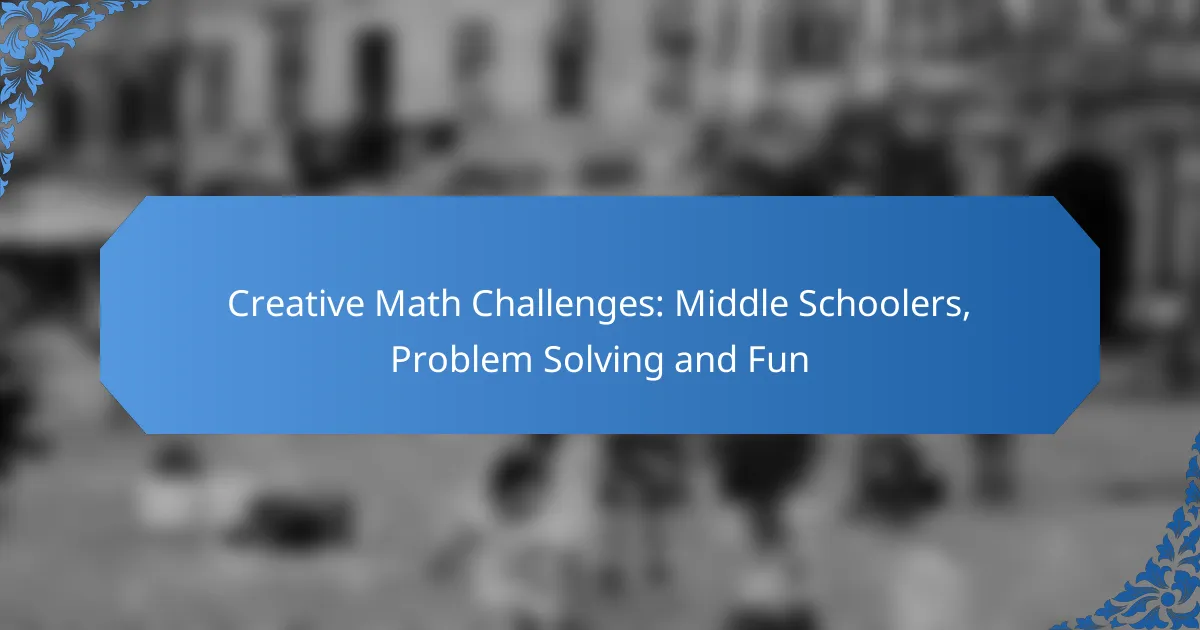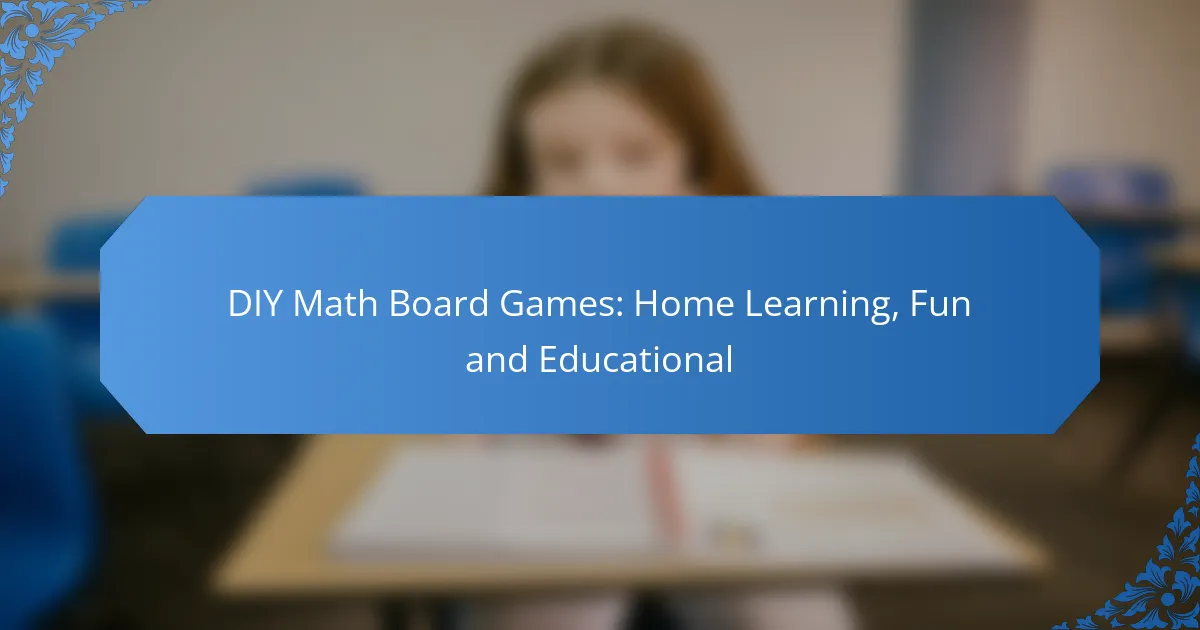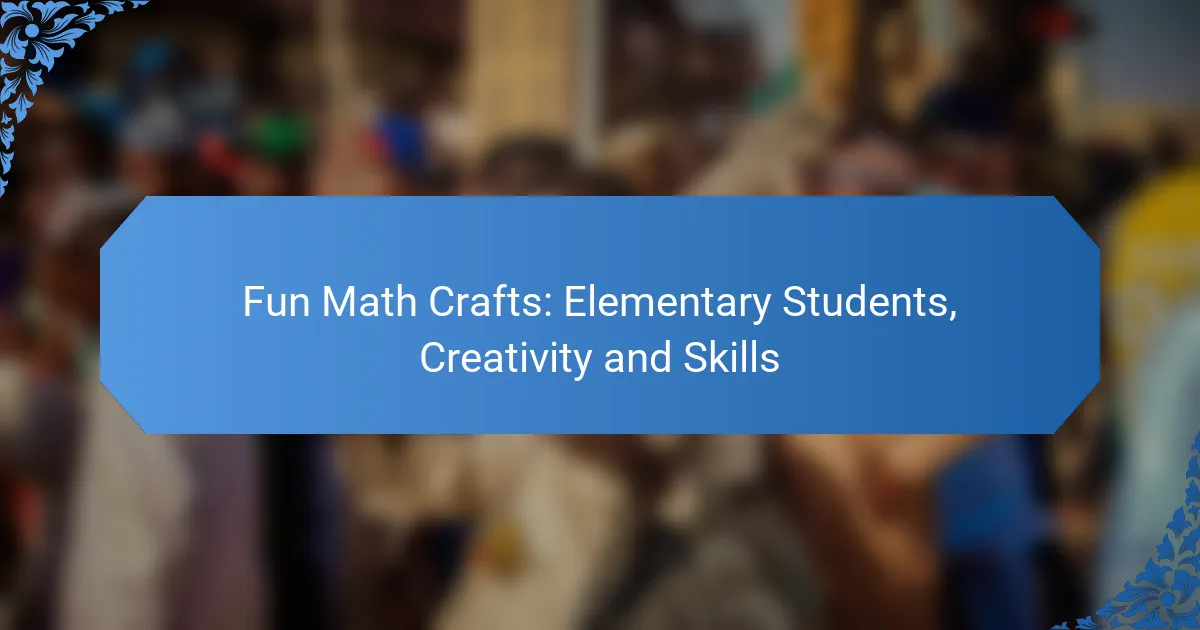Creative math challenges are an excellent way to engage middle schoolers, transforming problem-solving into an enjoyable and relevant experience. By incorporating fun activities and relatable scenarios, these challenges stimulate critical thinking and foster a lasting appreciation for mathematics.
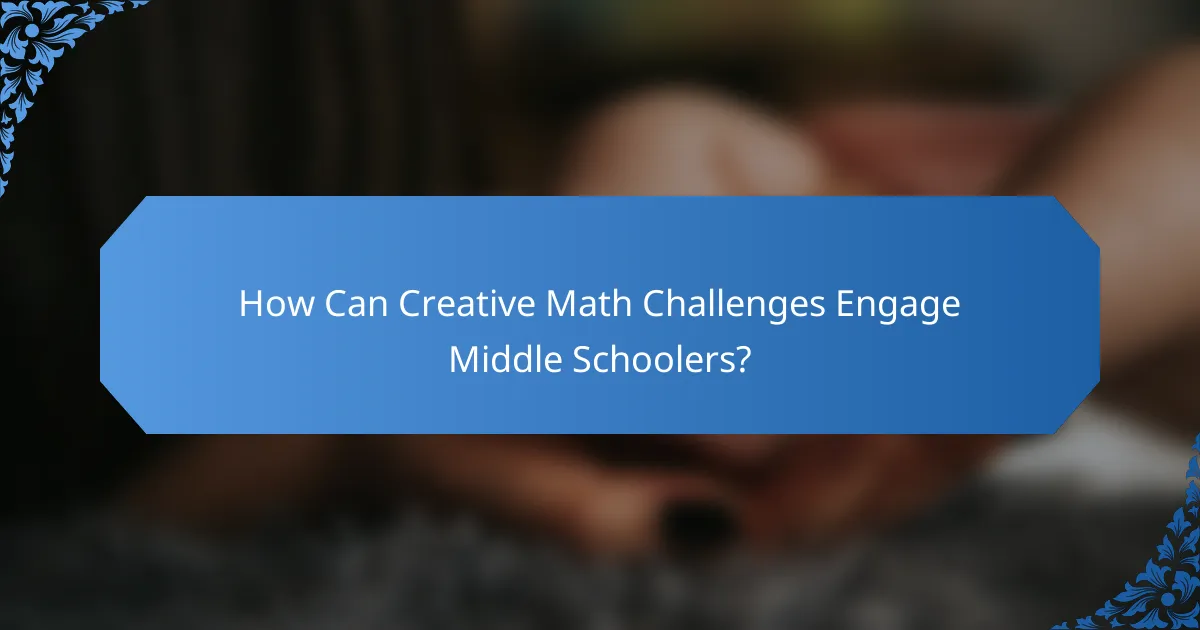
How Can Creative Math Challenges Engage Middle Schoolers?
Creative math challenges can significantly engage middle schoolers by making problem-solving enjoyable and relevant. These activities stimulate critical thinking and foster a love for mathematics through interactive and relatable scenarios.
Interactive problem-solving
Interactive problem-solving encourages students to actively participate in their learning process. By presenting challenges that require hands-on involvement, students can explore mathematical concepts in a dynamic way. For instance, using puzzles or escape room scenarios can make math feel like an adventure.
Teachers can facilitate this by incorporating group activities where students solve problems together, allowing them to share strategies and insights. This collaboration not only enhances understanding but also builds confidence in their abilities.
Real-world applications
Connecting math challenges to real-world applications helps students see the relevance of what they learn. For example, tasks that involve budgeting for a school event or planning a trip can make mathematical concepts more tangible. This approach demonstrates how math is used in everyday life, making it more appealing to students.
Incorporating local contexts, such as using local currency for budgeting exercises, can further enhance engagement. Students are more likely to invest effort in challenges that relate to their own experiences and environments.
Collaborative learning
Collaborative learning promotes teamwork and communication among students, which can lead to deeper understanding of math concepts. Group challenges encourage students to discuss their thought processes and learn from one another. This peer interaction can clarify misunderstandings and reinforce learning.
To implement collaborative learning effectively, educators can assign roles within groups, such as a facilitator or a recorder, to ensure that all students contribute. This structure can help maintain focus and accountability during problem-solving activities.
Gamification techniques
Gamification techniques can transform traditional math challenges into engaging games that motivate students. By incorporating elements like points, levels, and rewards, educators can create a competitive yet fun atmosphere. For example, using math-based games or online platforms can enhance student participation and enthusiasm.
It’s essential to balance competition with collaboration, ensuring that students support each other while striving for personal achievement. This approach can foster a positive learning environment where students feel encouraged to take risks and explore new concepts.
Visual aids and manipulatives
Visual aids and manipulatives can significantly enhance understanding by providing concrete representations of abstract concepts. Tools like graphs, charts, and physical objects can help students visualize problems, making them easier to solve. For example, using blocks to represent fractions can clarify their relationships.
Incorporating technology, such as interactive whiteboards or math software, can also provide dynamic visualizations that engage students. When selecting aids, consider the specific concepts being taught and choose tools that best illustrate those ideas for maximum impact.

What Are Effective Creative Math Challenge Examples?
Effective creative math challenges engage middle schoolers by combining problem-solving with fun activities. These challenges can take various forms, encouraging students to apply mathematical concepts in innovative and interactive ways.
Escape room math challenges
Escape room math challenges require students to solve a series of math problems to “escape” from a themed room. These problems often involve puzzles that integrate algebra, geometry, and logic, making them exciting and educational. Teachers can create scenarios where students must work in teams to unlock clues and complete tasks within a set time limit.
To implement this, consider using a mix of math problems that cater to different skill levels. For example, you might include basic arithmetic for some clues and more complex equations for others. This variety keeps all students engaged and challenged.
Math scavenger hunts
Math scavenger hunts involve students searching for items or clues that relate to math concepts, often in a designated area like a classroom or schoolyard. Each clue can lead to a math problem that must be solved to find the next location. This hands-on approach encourages movement and teamwork while reinforcing math skills.
To organize a scavenger hunt, create a list of math-related tasks that can be completed at each location. For instance, students might need to measure the length of a bench or calculate the area of a playground. Ensure the tasks are age-appropriate and varied to maintain interest.
Math art projects
Math art projects combine creativity with mathematical concepts, allowing students to express their understanding through visual means. These projects can include creating geometric shapes, tessellations, or even using symmetry in art. This approach helps students see the beauty in math while developing their artistic skills.
When planning a math art project, provide students with clear guidelines and examples. For instance, they could create a mural that incorporates patterns based on mathematical sequences. Encourage them to explain the math behind their artwork, reinforcing their learning.
STEM-based challenges
STEM-based challenges integrate science, technology, engineering, and math, promoting critical thinking and problem-solving skills. These challenges can involve building structures, coding simple programs, or conducting experiments that require mathematical calculations. They help students understand the real-world applications of math.
To create an engaging STEM challenge, consider a project like designing a bridge using specific materials. Students can calculate the weight limits and dimensions, applying their math skills in a practical context. Ensure that the challenge is suitable for their skill level and encourages collaboration.
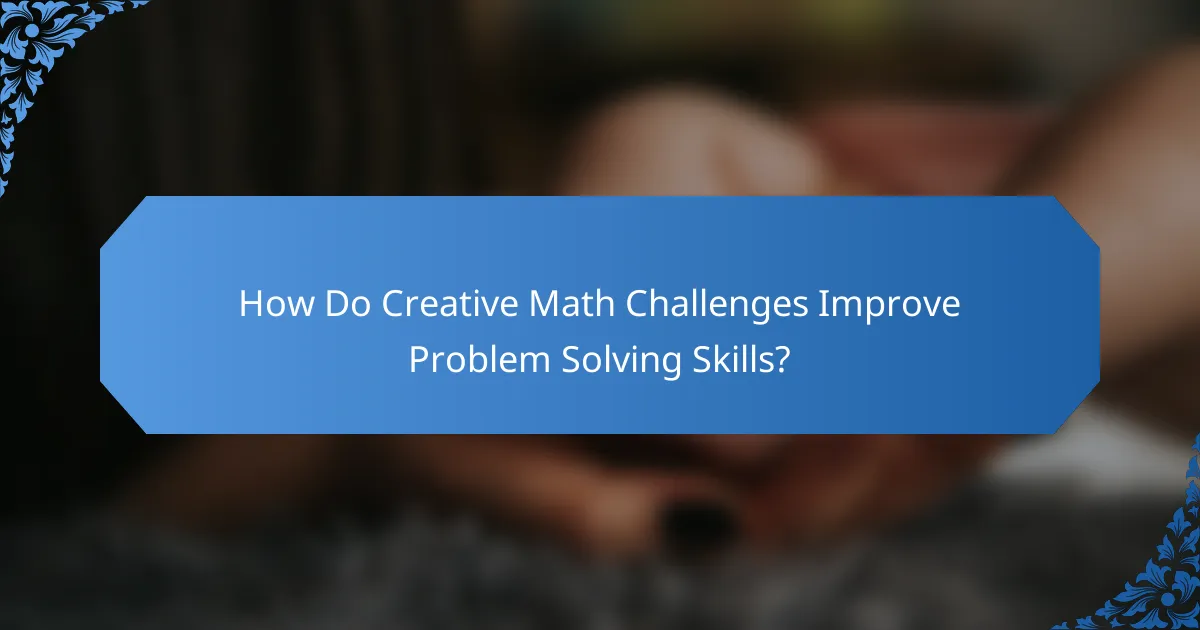
How Do Creative Math Challenges Improve Problem Solving Skills?
Creative math challenges enhance problem-solving skills by engaging students in innovative ways that require critical thinking and adaptability. These activities encourage exploration and experimentation, allowing middle schoolers to develop a deeper understanding of mathematical concepts.
Critical thinking development
Creative math challenges stimulate critical thinking by presenting problems that lack straightforward solutions. Students must analyze different approaches, weigh options, and make decisions based on their findings. This process fosters an environment where questioning and reasoning become essential tools for learning.
For example, a challenge might ask students to find multiple ways to reach a target number using a limited set of operations. This not only encourages diverse thinking but also helps students recognize patterns and relationships in numbers.
Encouragement of perseverance
Perseverance is crucial in problem-solving, and creative math challenges teach students to persist through difficulties. When faced with complex problems, students learn to embrace challenges rather than shy away from them. This resilience is vital for their academic growth and personal development.
In practice, educators can design challenges that require multiple attempts to solve. For instance, a puzzle that initially seems unsolvable can be revisited after students gather more information or insights, reinforcing the idea that persistence leads to success.
Application of mathematical concepts
Creative math challenges provide a platform for students to apply mathematical concepts in real-world scenarios. By integrating math with everyday situations, students can see the relevance of their studies and how math functions outside the classroom.
For example, a challenge might involve budgeting for a school event, requiring students to use addition, subtraction, and multiplication to manage costs effectively. Such applications help solidify their understanding and make learning more engaging.
Enhancement of logical reasoning
Logical reasoning is a fundamental aspect of problem-solving, and creative math challenges enhance this skill by requiring students to follow structured thought processes. As they work through problems, they learn to construct logical arguments and deduce conclusions based on evidence.
Teachers can incorporate logic puzzles or riddles that require students to think critically about the information presented. For instance, a challenge that involves figuring out the correct sequence of events based on given clues can sharpen their reasoning abilities and improve their overall analytical skills.
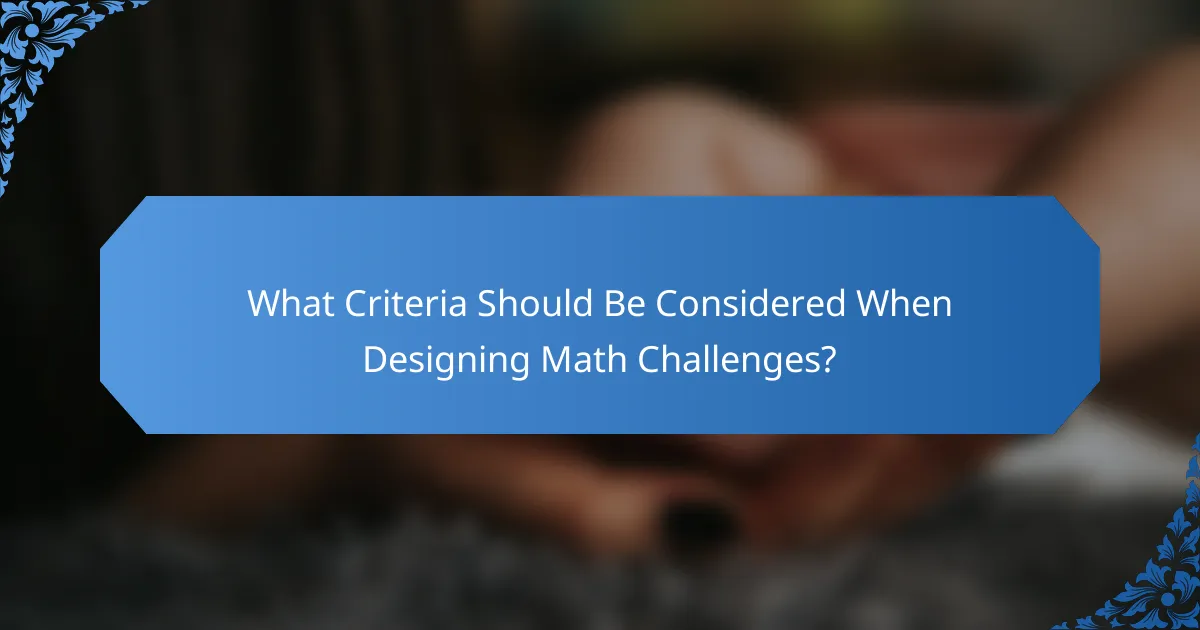
What Criteria Should Be Considered When Designing Math Challenges?
When designing math challenges for middle schoolers, it is crucial to consider factors like age-appropriate difficulty, alignment with curriculum standards, and the incorporation of diverse learning styles. These criteria ensure that the challenges are engaging, educational, and accessible to all students.
Age-appropriate difficulty
Math challenges should be tailored to the cognitive and skill levels of middle school students, typically aged 11 to 14. This means incorporating problems that are neither too simple nor overly complex, striking a balance that promotes engagement and learning.
A good rule of thumb is to create challenges that align with the students’ current math curriculum, allowing them to apply what they have learned in class. For instance, problems involving basic algebra or geometry concepts can be effective, as they are commonly taught during this age range.
Alignment with curriculum standards
Ensuring that math challenges align with national or state curriculum standards is essential for effective learning. This alignment helps reinforce the skills and concepts that students are expected to master at their grade level.
For example, if the curriculum emphasizes problem-solving and critical thinking, challenges should include real-world applications of math that require students to analyze and reason through problems. Familiarity with these standards can guide educators in selecting or designing appropriate challenges.
Incorporation of diverse learning styles
Recognizing that students have varied learning styles is vital when designing math challenges. Some students may excel with visual aids, while others may prefer hands-on activities or verbal explanations. Incorporating a mix of these approaches can enhance engagement and understanding.
For instance, using manipulatives for geometric problems or incorporating technology like math games can cater to different preferences. Additionally, providing options for students to choose how they approach a challenge can foster a sense of ownership and motivation in their learning process.
